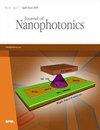无序光子晶体结构中界面模式局域化分析
IF 1.1
4区 物理与天体物理
Q4 NANOSCIENCE & NANOTECHNOLOGY
引用次数: 6
摘要
摘要对一种无序光子晶体(D-PhC)结构进行了分析,研究了界面模式的局域化特性。该设计包括双层无序PhC结构,其中层以Thue–Morse序列(TMS)排列。在更宽的波长范围内,还考虑了局部对称子结构对本征态耦合的影响。分别在550632.8和750nm的工作波长下,对TMS结构的不同折射率对比度值进行模式杂交研究。色散分析证实了结构局部谐振器处不同入射角的体导和边缘导模的局部化。此外,增加RI对比度值导致产生非常高电场强度的混合界面模式。因此,显示了其在传感和光导应用中的潜在应用。此外,由于较高的表面电场强度,该结构也可用于基于荧光的检测和表面增强拉曼光谱。本文章由计算机程序翻译,如有差异,请以英文原文为准。
Analysis of interface mode localization in disordered photonic crystal structure
Abstract. A disordered photonic crystal (D-PhC) structure is analyzed to study the interface mode localization characteristics. The design comprises a bilayer-disordered PhC structure, where layers are arranged in Thue–Morse sequence (TMS). The impact of local symmetric substructures on eigenstates coupling is also considered over a wider wavelength range. The mode hybridization study is carried out for varying refractive index contrast values of TMS structures at an operating wavelength of 550, 632.8, and 750 nm, respectively. The dispersion analysis confirms the localization of bulk guided, and edge-guided modes for different incidence angles at the structural local resonators. Further, increasing the RI contrast value leads to generation of hybrid interface modes of very high electric field intensity. Thus, showing its potential applications in both sensing and light guiding applications. Moreover, because of the higher surface electric field intensity this structure can also be used for fluorescence-based detection and surface-enhanced Raman spectroscopy as well.
求助全文
通过发布文献求助,成功后即可免费获取论文全文。
去求助
来源期刊

Journal of Nanophotonics
工程技术-光学
CiteScore
2.60
自引率
6.70%
发文量
42
审稿时长
3 months
期刊介绍:
The Journal of Nanophotonics publishes peer-reviewed papers focusing on the fabrication and application of nanostructures that facilitate the generation, propagation, manipulation, and detection of light from the infrared to the ultraviolet regimes.
 求助内容:
求助内容: 应助结果提醒方式:
应助结果提醒方式:


